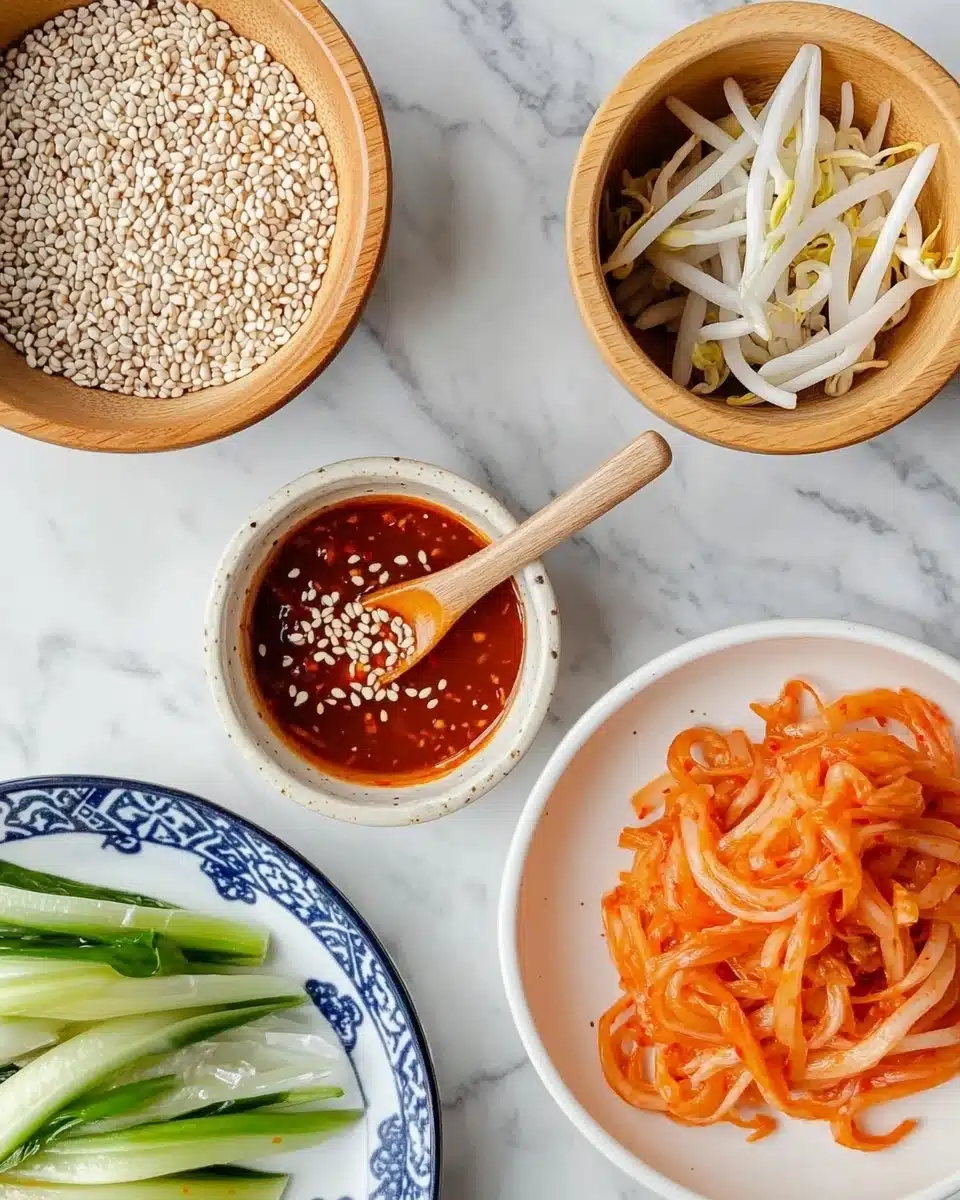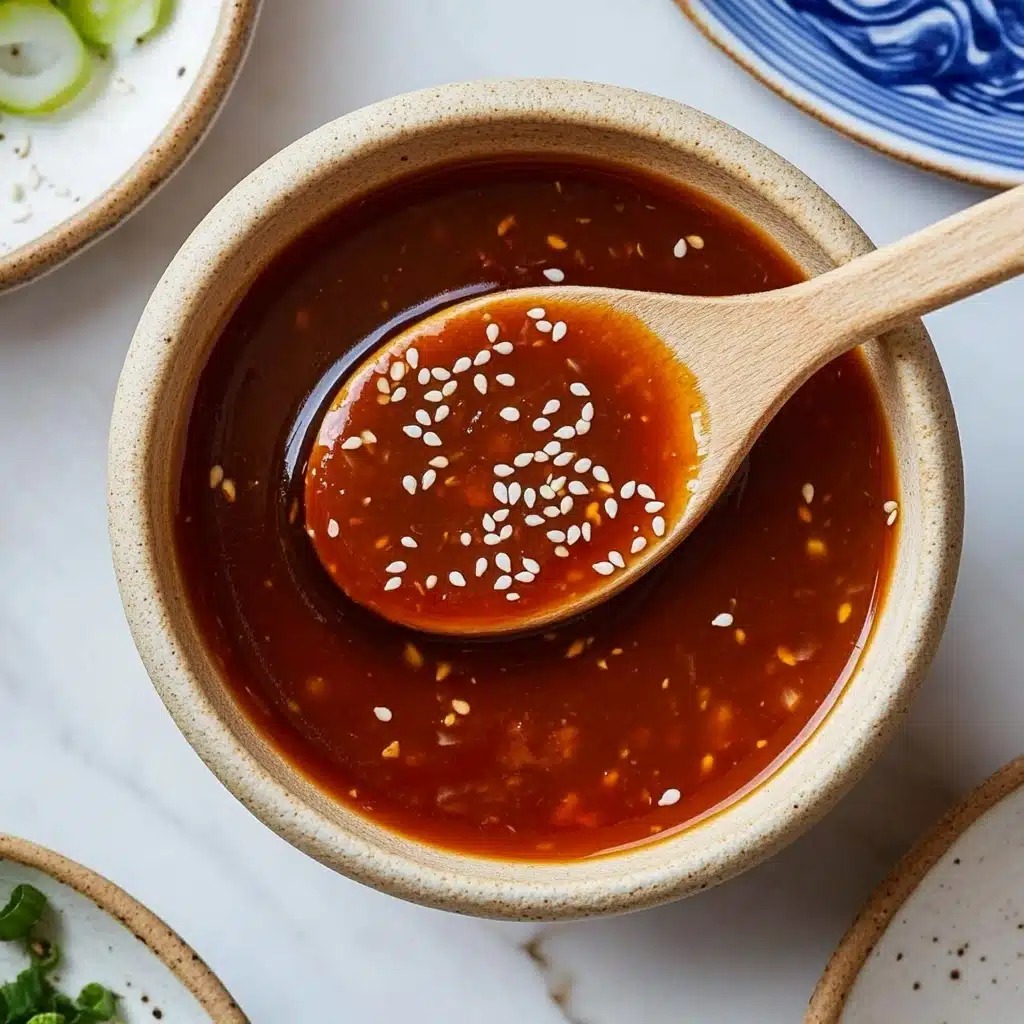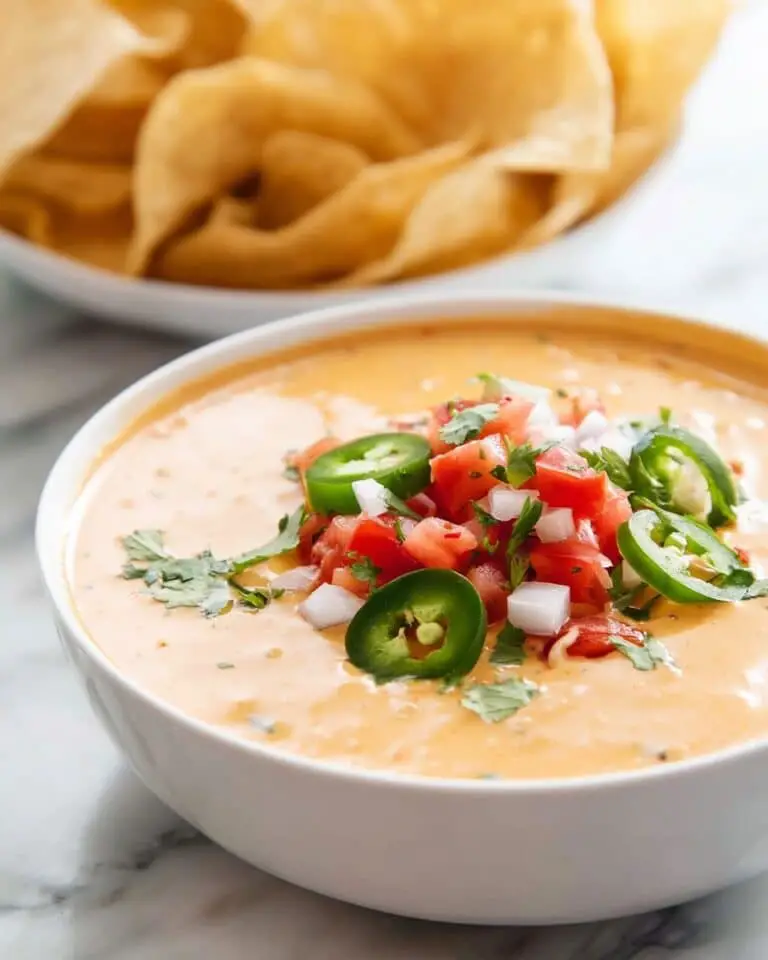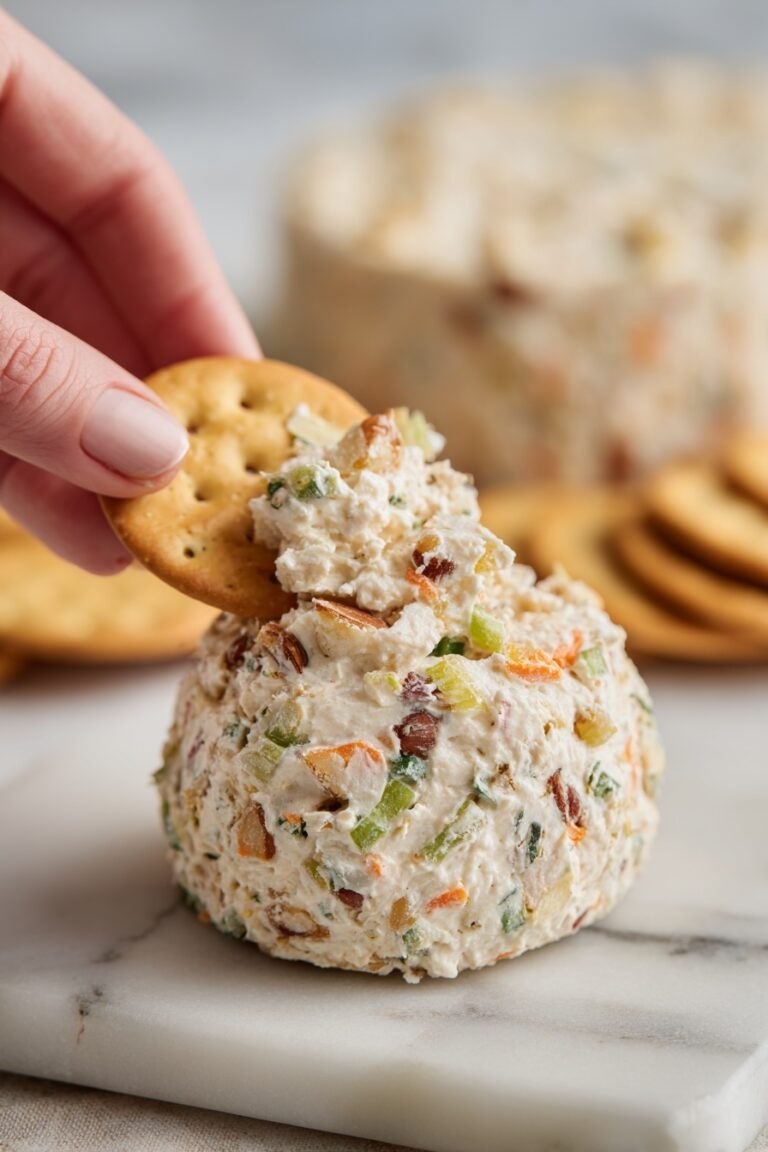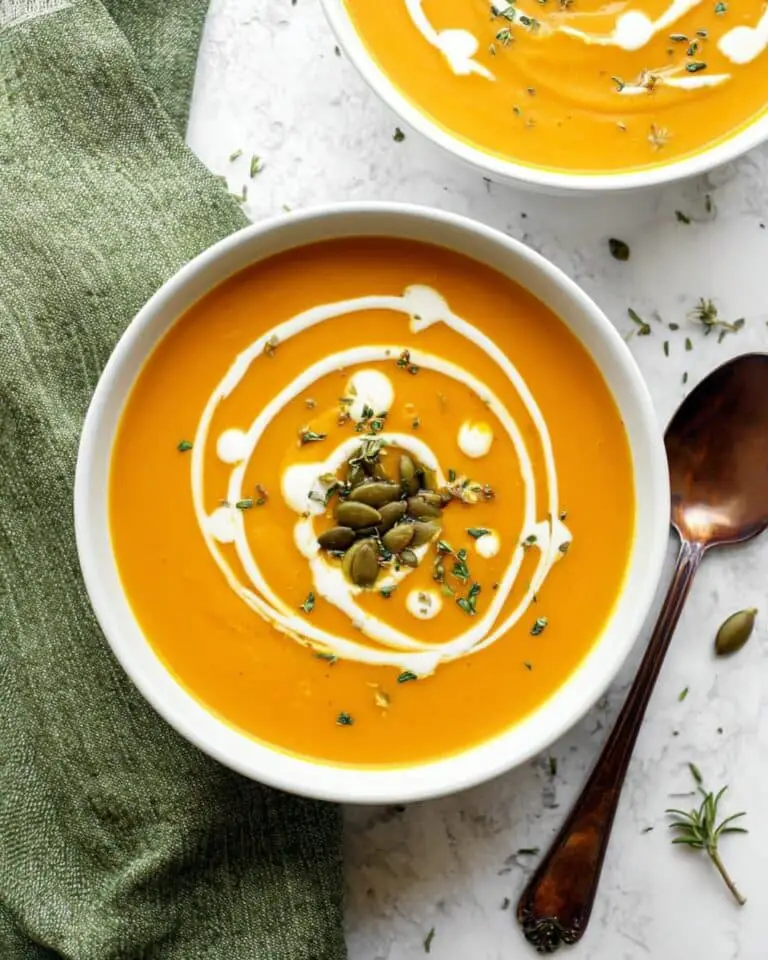If you’re on the prowl for a punch of flavor that transforms everything it touches, let me introduce you to my absolute favorite Spicy Gochujang Sauce! With a perfect blend of savory, sweet, and heat, this Korean-inspired condiment comes together in minutes—yet adds layers of irresistible taste to bowls, veggies, noodles, and more.
Why You’ll Love This Recipe
- Incredibly Quick: You can whip up this Spicy Gochujang Sauce in just five minutes—perfect for last-minute flavor boosts!
- Super Versatile: It shines on veggie bowls, roasted veggies, noodles, crispy tofu, or even drizzled over pizza for a bold twist.
- Customizable Heat: Adjust the gochujang to your taste—mild or extra spicy, just the way you like it.
- Simple, Clean Ingredients: Only four ingredients—each one packs a punch and comes together for a vibrant, complex sauce.
Ingredients You’ll Need
Let’s take a peek at what you’ll need to stir up this magic! These essentials are probably already in your pantry, and each one plays a starring role in building the trademark depth, zip, and body of Spicy Gochujang Sauce.
- Gochujang paste: This Korean fermented chili paste brings the sauce’s signature heat, umami, and a hint of sweetness. Different brands have unique flavor profiles, so sample your favorites!
- Rice vinegar: Adds bright acidity, balancing out the richness of the gochujang and cutting through the sauce for a clean finish.
- Sesame oil: Nutty and toasty, just a splash rounds out the flavors with a subtle richness and sheen.
- Maple syrup: For a gentle sweetness that ties everything together, maple syrup plays the perfect counterpoint to the spice and tang.
Variations
The beauty of Spicy Gochujang Sauce is how endlessly adaptable it is! Feel free to customize it based on your cravings, what you have on hand, or any dietary preferences—there’s no wrong way to let your creativity shine.
- Add garlic: A fresh minced clove or a little garlic powder will introduce a savory depth and extra zing to your sauce.
- Swap sweeteners: Try agave, honey, or brown sugar if you don’t have maple syrup, each giving a subtle twist.
- Make it gluten-free: Use a certified gluten-free gochujang paste, as some brands contain wheat for fermentation.
- Adjust tang: Experiment with apple cider vinegar or lime juice for a new citrusy angle.
How to Make Spicy Gochujang Sauce
Step 1: Gather and Measure Ingredients
Grab your gochujang paste, rice vinegar, sesame oil, and maple syrup, then measure each one into a small mixing bowl. This recipe is all about balance, so be generous with your measuring spoons for best results.
Step 2: Whisk Together for Creamy Perfection
Using a small whisk or fork, blend everything together until the mixture is totally smooth and slightly glossy. You’re looking for a creamy, pourable consistency—add a splash more vinegar or a drizzle of water if you prefer a thinner sauce.
Step 3: Taste and Tweak the Spice Level
Give your Spicy Gochujang Sauce a welcome taste from the spoon. If you love things fiery, add a little more gochujang paste. For milder flavors, simply stick to the lower end of the measurement or add a touch more maple syrup to mellow the heat.
Pro Tips for Making Spicy Gochujang Sauce
- Brand Matters: Gochujang paste varies widely—taste your brand before adding, and adjust for sweetness and heat as needed.
- Smooth Texture Every Time: If your sauce looks lumpy, keep whisking, or pass it through a small mesh strainer for super-silky results.
- Batch Prep: Double or triple the recipe for meal prep—you’ll love having a jar of this in the fridge for quick meals all week!
- Balance Sweet + Heat: Don’t be afraid to fine-tune the maple syrup and vinegar amounts to create your own signature sauce.
How to Serve Spicy Gochujang Sauce

Garnishes
Top your finished sauce with a sprinkle of toasted sesame seeds, sliced scallions, or a dash of crushed red pepper flakes for a beautiful hit of color and crunch. A little chopped cilantro or a sprinkle of black sesame seeds can make it look as dazzling as it tastes!
Side Dishes
Spicy Gochujang Sauce is a natural partner for bibimbap, steamed rice bowls, roasted or steamed vegetables, grilled tofu, or even simple sautéed greens. Try drizzling it over dumplings or use as a dipping sauce for spring rolls—the pairing possibilities are endless!
Creative Ways to Present
Serve your sauce in a tiny dipping dish alongside veggie sushi, spooned over a dramatic platter of rainbow veggies, or as a surprise layer on a fusion pizza. For parties, offer it as a shot glass shooter for dipping skewers or crispy fries—it always gets people talking!
Make Ahead and Storage
Storing Leftovers
Keep any extra Spicy Gochujang Sauce in a clean, airtight jar in the fridge. It holds up beautifully for about a week (though odds are it’ll disappear sooner) and is always there to save dinner in a pinch.
Freezing
While this sauce is so quick to make, you can certainly freeze it for longer storage. Just pop it in a freezer-safe small container or ice cube tray—thaw in the fridge and give it a good stir before using.
Reheating
Gochujang sauce is typically used cold or at room temperature, but if you’d like it warm, gently microwave in short bursts or set the jar in warm water for a few minutes. Just whisk before serving to bring it back to a perfect, creamy consistency.
FAQs
-
Is Spicy Gochujang Sauce very hot?
It all depends on how much gochujang paste you use! Start with less for a mild kick, or add more for a bolder, fiery flavor—the great part is, you’re in charge of the spice level each time.
-
Can I replace the maple syrup?
Absolutely! Honey, agave, or brown sugar all work as swaps—each gives its own unique sweetness, so feel free to experiment based on what you like or have on hand.
-
How do I use Spicy Gochujang Sauce besides rice bowls?
Try it on grilled or roasted vegetables, slathered on grain bowls, drizzled over tacos, tossed with noodles, or even as a dip for fries, dumplings, or pizza. It makes everything more exciting!
-
Is Spicy Gochujang Sauce gluten-free and vegan?
Most brands of gochujang do contain wheat, but you can seek out certified gluten-free versions. As written, the recipe is vegan—just ensure all your ingredients meet your dietary needs!
Final Thoughts
Spicy Gochujang Sauce is one of those recipes you’ll want to keep on repeat! It’s bold, versatile, and so simple to make—go ahead and let it become your not-so-secret weapon for adding instant excitement to everyday meals. I can’t wait for you to try it and fall in love with all the possibilities!
Print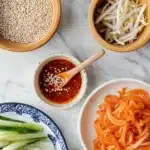
Spicy Gochujang Sauce Recipe
- Prep Time: 5 minutes
- Total Time: 5 minutes
- Yield: 4 servings
- Category: No-Cook
- Method: No-Cook
Description
A flavorful and versatile Gochujang sauce recipe that combines the perfect balance of sweetness, heat, and umami flavors. This sauce is ideal for adding a spicy kick to bibimbap bowls or as a delicious dressing for veggie rice bowls.
Ingredients
Gochujang Sauce:
- 2 to 3 tablespoons gochujang paste*
- 1 1/2 tablespoons rice vinegar
- 1 tablespoon sesame oil
- 1 tablespoon maple syrup
Instructions
- Prepare Gochujang Sauce: In a small bowl, whisk together the gochujang paste, rice vinegar, sesame oil, and maple syrup. Adjust the amount of gochujang paste to control the spiciness of the sauce.
- Serve: Spoon the sauce onto bibimbap bowls or use it as a flavorful dressing for any vegetable rice bowl.
Notes
- *I recommend using Mother in Law’s Gochujang for authentic flavor; adjust the amount based on personal spice preference.
Nutrition
- Serving Size: 1 serving

